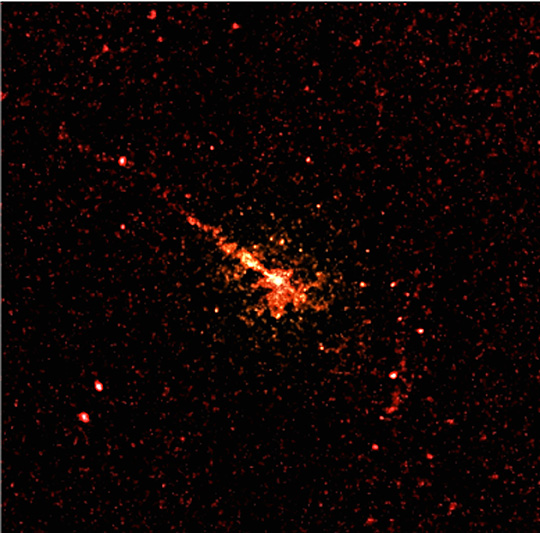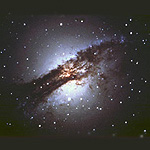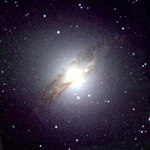CXC Home | Search | Help | Image Use Policy | Latest Images | Privacy | Accessibility | Glossary | Q&A
What Do These Images Tell Us?
Cen A gets its name from radio astronomy. It is one of the first radio sources to be identified with a galaxy- NGC 5128. As the nearest active radio galaxy, it has been well studied by astronomers and is considered a prototype of a major class of "low-luminosity" active galaxies.
Xray

Angular size of the box = 15 arc min, corresponding to 50,000 light years. Photo:NASA/CXC/SAO
The Chandra X-ray image of Cen A shows a bright source in the nucleus of the galaxy, which is probably due to a supermassive black hole. The bright jet extending out from the nucleus to the upper left is due to explosive or highly energetic activity around the black hole which ejects matter at high speeds from the vicinity of the black hole. A faint "counter jet" extending to the lower right can also be seen. This jet is probably pointing away from us. Numerous point-like sources of X rays are also apparent. These are probably due to neutron stars or black holes that are accreting matter from nearby companion stars.
Optical

Angular size of box = 7.5 arc min, corresponding to 25,000 light years. Photo:AURA/NOAO/NSF
Optical images show that NGC5128 is an elliptical galaxy with huge dust lanes across the middle of the galaxy. This has led astronomers to speculate that Cen A was the site of a merger between a small spiral galaxy and a large elliptical galaxy several hundred million years ago. The optical radiation is primarily from stars.
Infrared

Angular size of box = 10 arc min, corresponding to 38,000 light years. Photo:2 MASS
The infrared image gives a better view of the dust lanes, as well as the brilliance of the central source. The infrared radiation is produced by cool stars with temperatures of "only" a few thousand degrees Celsius, and by dust that has been heated to a few hundred to a thousand degrees.
Radio

Angular size of box = 12.5 arc min corresponding to 42,000 light years. Photo:NRAO/AUI
The radio image shows striking jet-like structures that flare out from the center of the galaxy. These structures have been traced well beyond the galaxy out to distances of 600,000 years. The total length of the radio jet shown here is about ten arc minutes, or about 30,000 light years in length. The radio emission is produced by the synchrotron process, in which high-energy electrons radiate as they spiral around the magnetic field of the galaxy.
Return to Centaurus A (25 Oct 99)


